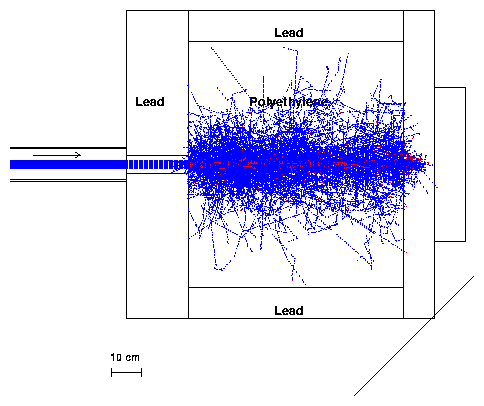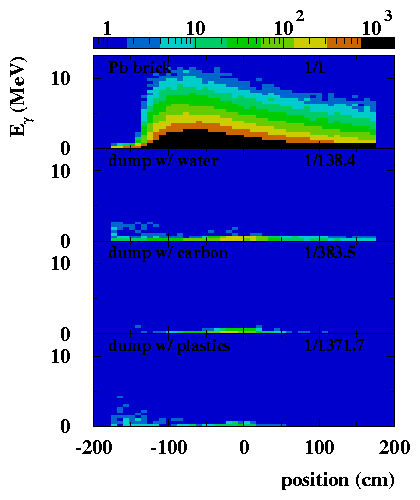|
Nuclear spectroscopy studies at the new ELBE facility will make use of energetic photons from Bremsstrahlung production. In order to minimize the background from scattered photons the secondary photon beam has to be removed after passing through the experiment's target. Several different solutions have been studied by thorough Monte-Carlo simulations using the GEANT [1] program package. 
As a result, the configuration shown in Fig. 1 gives the minimal backscattering of photons towards the target area. It consists of a cylindrical inner absorber made from Polyethylene (PE) with a diameter of 80 cm and a length of 70 cm. This inner absorber is surrounded by a lead shielding with a thickness of 20 cm in axial and 10 cm in radial direction.

Fig. 2 Spectral (ordinate) and position distribution (abscissa) of photons emerging from the photon beam dump and crossing a plane tilted by an angle of p/4 with respect to the photon beam. Different setups for the internal absorber of the beam dump are indicated with the integrated yield normalized to the first alternative featuring simply a lead brick at the end of the beam pipe. Different intensities follow a logarithmically scaled geographical colour map as shown on top.
The selection of a low-density material like PE
appears disadvantageous since it results in a large setup.
Nevertheless, the high neutron production threshold and
low (g,n) cross section of 18.7 MeV for Carbon
(for the most abundant isotope C-12) clearly favours
PE as compared to lead.
Moreover, Compton backscattering of photons for PE is reduced
as compared to water by the lower mean atomic number density
in PE.
This lower atomic number of PE additionally lowers pair
production and subsequently positron annihilation photons.
Table 1 Natural abundances and one-neutron separation energies for different isotopes used in the calculations. References [1] CERN Program Library Long Writeup Q121, CERN, Geneva (CH), 1994
|